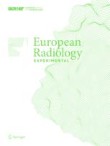European Radiology Experimental is owned by the European Society of Radiology.
Impact of iodine concentration and scan parameters on image quality, contrast enhancement and radiation dose in thoracic CT
We investigated the impact of varying contrast medium (CM) densities and x-ray tube potentials on contrast enhancement (CE), image quality and radiation dose in thoracic computed tomography (CT) using two diff...
